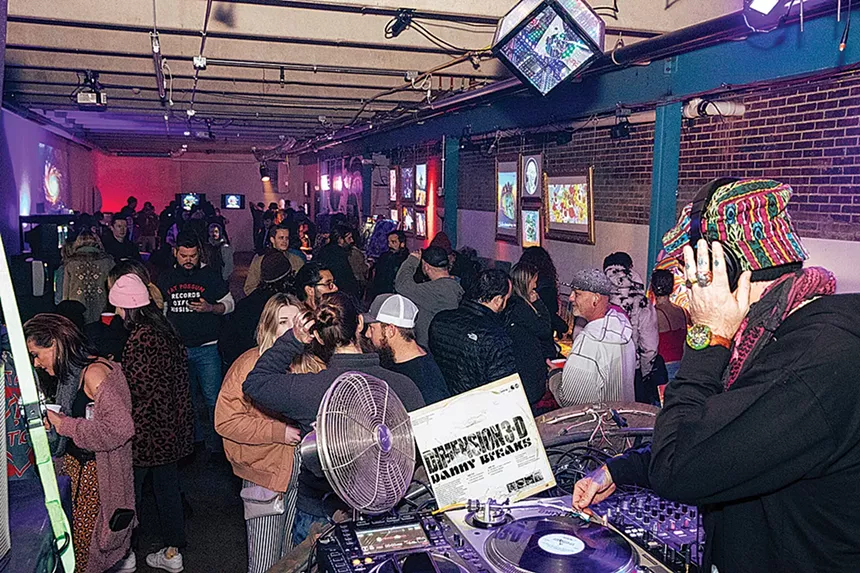The Galaktic Gang isn’t the only Colorado group over the moon about cryptocurrency and the potential of NFTs.
Danny Newman — Denver bar owner and tech guru — was an early convert to NFTs, and preaches on the topic to others. “The blockchain is a public ledger. So it is a publicly accessible ledger. Just think of, you know, an Excel spreadsheet that everyone can see at any point. And as you add more rows to that, everyone can see what’s going on,” Newman explained during a March 22 introduction to NFTs event at the Ramble Hotel.
Part of the Invisible City meetup series, Newman’s talk drew close to 100 attendees, many of them younger professionals and artists. But there were also dozens of older people interested in learning about a new technology.
“Each new row that you’re adding — we’ll call that a block — is being mathematically compared to the ones before it by everyone that is part of the overall network. And so everyone’s programming — math — needs to line up and be the same for that block to be officially added to the chain,” Newman continued. “So you literally have blocks that are all chained together. And that is what gives everyone confidence that something in block, you know, 444, happened, and everyone agrees about it.”

Danny Newman was an early convert to NFTs.
Invisible City
When Bitcoin first went live in 2009, it had little to no value. By 2011, it was worth $1. But since then, the currency has skyrocketed, peaking in April 2021 at $64,800, dropping to $30,000 a month later, and then hitting $66,974.77 in October. Right now the price of Bitcoin is around $42,000. Some people have gotten unfathomably rich from investing in cryptocurrency; others have lost fortunes. Gambling on the price volatility of the currency is just part of the appeal.
People around the globe are now envisioning a new approach to currency, one that can cut out banks, cut out governments and create a more autonomous monetary system. One such vision is behind Ethereum, co-founded by a group of tech wizards, including Russian-Canadian tech wunderkind Vitalkin Buterin, in 2015. Ethereum is another open-source blockchain that’s akin to Bitcoin, except that it has even more potential. “What Ethereum did that is super unique is that instead of just kind of posting transactions — so, posting kind of monetary flows of money — Ethereum added the concept of smart contracts,” Newman said.
In essence, a smart contract says, “If someone pays this amount of money, then they get that.”
Smart contract capability combined with blockchain technology to fuel the advance of NFTs, non-fungible tokens. “A non-fungible token is something that can’t be replicated. It’s a one of one. You know, the Mona Lisa is a non-fungible painting; it can’t be copied,” Newman continued. “The example a lot of people use for fungible tokens are U.S. dollars. We all have a bunch of dollars. I can exchange my $1 for your $1.”
An NFT is essentially the receipt for an item that proves its authenticity. The most common item is a digital image or video, but NFTs can also be used for augmented reality, songs and even more rudimentary things such as land deeds and wills.
In 2017, a studio dropped the CryptoPunks NFT collection, the first 10,000-item NFT portfolio. That same year brought the CryptoKitties collection into the world. But NFTs really started to go gangbusters in 2021, with the sale of the Bored Ape Yacht Club, which had celebrities purchasing NFTs from the collection for astronomical amounts of money. Justin Bieber bought one for $1.29 million. Owners of Bored Apes have access to private virtual clubs and exclusive events, and can also print T-shirts and make merchandise using their specific Bored Ape.
What determines the value of an individual NFT associated with Bored Ape is what determines the value of any piece of art: hype, rarity and perceived aesthetics. The Bored Apes aren’t especially remarkable, but the hype has helped the value balloon.
While Colorado doesn’t have a Bored Ape Yacht Club, it has some incredible NFT art.
In 2019, Annie Phillips, a longtime art director in Colorado, founded IRL Art, a digital arts collective. IRL Art has six full-time team members, and is also behind the IRL Underground NFT gallery at 2601 Walnut Street. She says that crypto technology has totally “empowered” artists, who now have more ability to get recognized and make money from their craft. Digital art NFTs, for example, sell for a certain value initially but then usually reward the artist with a certain percentage from every resale.
“In this case, the [NFT is an] art-related receipt that can be tracked online, and this receipt can also give you certain perks and amenities, which is what each NFT community has to come up with — it’s called a utility. And the utility behind each project is pretty much what determines price action,” explains Kyle Morton, one of the three Colorado-based co-founders of Galaktic Gang.

The Galaktic Gang launch party at IRL Gallery.
Courtesy of the Galaktic Gang
NFT art was a big draw at Ethereum Denver, a hugely popular conference that brought 10,000 attendees, including Buterin, Kimbal Musk and Andrew Yang to Denver in February. “This idea of having scarce digital property that you can create, sell and interact with is now a thing,” notes Kent Barton, the founder of Ethereum Denver.
Even Governor Jared Polis addressed the ETHDenver crowd. “This is, without a doubt, the most fun thing that I get to do this month,” he said. He later posted a photo in which he posed alongside Buterin.
While Polis is working on making Colorado’s economy blockchain-friendly, the state is already turning into a hub for NFT artists like 34-year-old Matt Treece, aka Eceertrey, a self-trained artist who used to work in the cannabis industry. “People here in Denver have seemingly been into it for years. I think because of the Ethereum Denver conference, the people here have been connected to the deeper development stuff that’s happening on the blockchain,” Treece says. “To me, it’s cool, because the art world seems so out of reach in the sense that the traditional galleries didn’t even understand what I was making.”
Treece’s NFTs often include three-dimensional objects sculpted onto landscape photos of the Western United States. He’s even made some of those sculptures using virtual-reality technology. Denver has “one of the strongest NFT scenes I’ve seen in real life in any city,” Treece says, comparing it favorably to the art hub of New York City and the crypto hub of Miami.
Another talented Colorado NFT artist is thirty-year-old Ally Grimm, aka A.L. Grime. “The tagline of my art is ‘the spiritual journey to the nexus of technology and humanity.’ I try to re-envision what a computer would experience if it tried to process human emotion,” she says. “I often portray the female figure. I think the feminine as the spirit of creation is the epitome of humanity.”
Grimm has an NFT mural displayed at the IRL gallery. She sends out physical paintings to buyers, as well as an NFT to show “authenticity.” The two items are linked through a chip in the painting. “I think in the coming months, I do want to just start doing some NFTs that exist only digitally, without the physical,” she says.
The NFT realm has opened new options for artists. “I have been basically making art my whole life and sell it and try to pursue the life goal of making art for a living. I’ve had a professional career for the last 25 years, as well. So that was always a side project, and now it’s hopefully the kind of thing that I can transition to full-time,” says 42-year-old Jeff Jagunich, aka JeffJag, a Denver-based abstract watercolor artist who works by day as a motion graphic designer. “I’ve made more selling NFTs this year than I’ve made selling art my whole life.”

No comments:
Post a Comment
Please follow us:
https://twitter.com/NFTWebUpdates
https://www.tumblr.com/blog/view/nftwebupdates